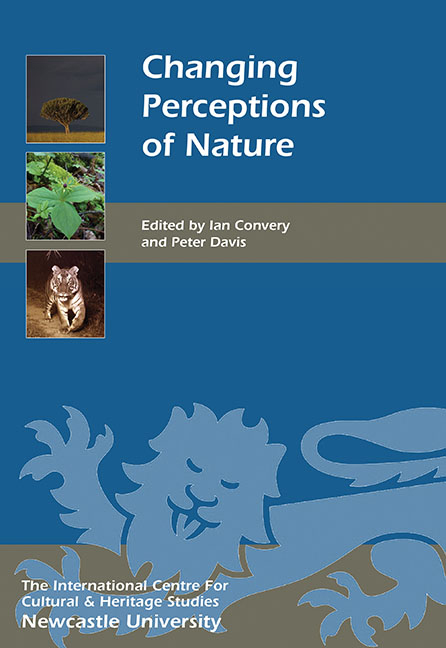Book contents
- Frontmatter
- Contents
- List of Illustrations
- Acknowledgments
- List of Abbreviations
- Foreword
- Introduction
- HISTORICAL PERSPECTIVES ON NATURE
- COLLECTING NATURE
- INTERPRETING NATURE AND LANDSCAPES
- CONSERVING NATURE
- PEOPLE–NATURE INTERACTIONS
- 22 Adventure, Nature and Commodification
- 23 Destination Nature: Wildlife and the Rise of Domestic Ecotourism in Britain, 1880–2015
- 24 Wild Places as Therapeutic Environments
- 25 Citizen Science and the Perception of Nature
- 26 Using Community-based Cultural Tourism to Enhance Nature Conservation in the Rupununi, Guyana
- 27 Representing Natural Heritage in Digital Space: from the National Museum of Natural History to Inuvialuit Living History
- 28 Out of the Wild Wood and into our Beds: the Evolutionary History of Teddy Bears and the Natural Selection of Deadly Cuteness
- 29 Rewilding: the Realisation and Reality of a New Challenge for Nature in the Twenty-first Century
- List of Contributors
- Index
- Miscellaneous Endmatter
25 - Citizen Science and the Perception of Nature
from PEOPLE–NATURE INTERACTIONS
Published online by Cambridge University Press: 26 October 2017
- Frontmatter
- Contents
- List of Illustrations
- Acknowledgments
- List of Abbreviations
- Foreword
- Introduction
- HISTORICAL PERSPECTIVES ON NATURE
- COLLECTING NATURE
- INTERPRETING NATURE AND LANDSCAPES
- CONSERVING NATURE
- PEOPLE–NATURE INTERACTIONS
- 22 Adventure, Nature and Commodification
- 23 Destination Nature: Wildlife and the Rise of Domestic Ecotourism in Britain, 1880–2015
- 24 Wild Places as Therapeutic Environments
- 25 Citizen Science and the Perception of Nature
- 26 Using Community-based Cultural Tourism to Enhance Nature Conservation in the Rupununi, Guyana
- 27 Representing Natural Heritage in Digital Space: from the National Museum of Natural History to Inuvialuit Living History
- 28 Out of the Wild Wood and into our Beds: the Evolutionary History of Teddy Bears and the Natural Selection of Deadly Cuteness
- 29 Rewilding: the Realisation and Reality of a New Challenge for Nature in the Twenty-first Century
- List of Contributors
- Index
- Miscellaneous Endmatter
Summary
HISTORY AND DEVELOPMENT OF CITIZEN SCIENCE
Amateur naturalists have always played an important role in developing our understanding of nature. As the editors of this volume indicate in the Introduction, before the emergence of the professional scientist it was provincial naturalists, men such as Gilbert White, who made enormous contributions to natural history (1993). White's 1789 book The Natural History and Antiquities of Selborne was a pioneering work of natural history and place, and remains one of the most frequently published titles in the English language (see also David Allen's The Naturalist in Britain (1976) for an excellent account of the evolution of natural history from the seventeenth to the early twentieth centuries). Today the term ‘citizen science’ is used increasingly to describe the involvement of ‘non-expert/non-professional’ scientists in research-related activities. Put simply, citizen science is a form of research collaboration where data gathering is performed by ‘non-expert’ individuals; these ‘non-experts’ are often members of the public (Catlin-Groves 2012). Typically this approach is used for large-scale scientific studies (Hart et al 2012) and projects that encourage the public to participate by acting as voluntary field assistants, gathering information to greatly increase datasets (Fowler et al 2013). These projects, however, can also be designed to recognise and incorporate culture and policy contexts surrounding conservation science (Freitag and Pfeffer 2013) and are thus part of the way in which perceptions of the natural world may change over time.
Citizen science usually incorporates an element of public education (Catlin-Groves 2012) and can dramatically improve public scientific literacy, encouraging more serious consideration of other relevant complex scientific issues (Hart et al 2012). Depending on the research project, citizen science can be beneficial to both the scientific community and the participants themselves. Participants can provide a solution to the limited funding and capacity to collect data while gaining valuable experience in scientific research, as well as educational and health benefits (Fowler et al 2013).
- Type
- Chapter
- Information
- Changing Perceptions of Nature , pp. 253 - 264Publisher: Boydell & BrewerPrint publication year: 2016

